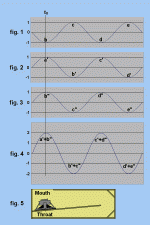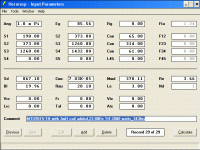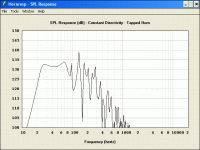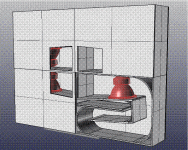iand said:
Many pro drivers from respected manufacturers with 4" coils are now rated at 1200W AES (continuous 2hrs pink noise rating). 2000W for a 5" coil is pretty ambitious but not impossible, depending on how effective the voice coil cooling is.
At least with pro drivers ithe power rating is usually a real figure which has been tested, as opposed to the higher but completely fictional numbers of many car drivers with 3" coils...
Yes, I think you are touching the essential subject here. _Respected manufacturers_ in the pro arena will clearly define what specifications the transducer can live up to. They will show hard numbers based on extensive testing in their QA department. Information on test specifications, running times, distortion tresholds, power specs (rms, aes, iec, etc.), even power compression ratios.
Basub does nothing of the kind, no time specs, no power specs, no distortion measurements. Just a claim to handle 2kW.
It is possible that the pasub390 is a very nice subwoofer. I wouldn't however put too much weight on their claims without any hard data to show for.
... Can't help liking their minimalistic webpage though. "'nuff said!" 😉
ion said:
Yes, I think you are touching the essential subject here. _Respected manufacturers_ in the pro arena will clearly define what specifications the transducer can live up to. They will show hard numbers based on extensive testing in their QA department. Information on test specifications, running times, distortion tresholds, power specs (rms, aes, iec, etc.), even power compression ratios.
Basub does nothing of the kind, no time specs, no power specs, no distortion measurements. Just a claim to handle 2kW.
It is possible that the pasub390 is a very nice subwoofer. I wouldn't however put too much weight on their claims without any hard data to show for.
... Can't help liking their minimalistic webpage though. "'nuff said!" 😉
I agree with everything you said -- and I assume that PAsub will have to do exactly the same to have any credibility in the market, so they will. Since the drivers are still in development I wouldn't expect all that to have been done yet.
Given the coil size and the XBL2 construction -- which is closer to underhung than overhung as far as heat dissipation goes -- I don't think the 2000W (AES?) target is over-optimistic, but it will have to be verified using life testing.
They do look very nice, but the proof of the pudding will be in real measured performance and pricing -- if they're double the price of existing high-end pro drivers then there won't be many takers, except for special applications (like tapped horns?) which need high power and Xmax for a given cone area -- you might as well use 2 "normal" drivers in most cases.
This is exactly the trap that Acoupower (and TC Sounds, and Aura/Seismic, and CGN, and Worx, and...) fell into -- great drivers technically in terms of what one driver can do, but high cost means they don't necessarily win compared to multiple normal drivers when measured in Vd or dB per dollar...
Ian
Ian: thanks for the info on the 3-string bass. I was a bass player in the "Old days" and was always frustrated by the poor frequency response of the pickups and speakers. In electronics lab, we tried to measure the fundamental from the open E string, and the highest we could get was about 10% of the total string energy, and that's before the losses in the amplifiers and speakers.
I've been playing in the back yard with my TH, and I got 124db at one meter with 30 VRMS @ 50 Hz. I can't crank it up any higher, this is a residential neighborhood, and they're looking for me now.
I've been playing in the back yard with my TH, and I got 124db at one meter with 30 VRMS @ 50 Hz. I can't crank it up any higher, this is a residential neighborhood, and they're looking for me now.
Don Snyder said:Ian: thanks for the info on the 3-string bass. I was a bass player in the "Old days" and was always frustrated by the poor frequency response of the pickups and speakers. In electronics lab, we tried to measure the fundamental from the open E string, and the highest we could get was about 10% of the total string energy, and that's before the losses in the amplifiers and speakers.
I've been playing in the back yard with my TH, and I got 124db at one meter with 30 VRMS @ 50 Hz. I can't crank it up any higher, this is a residential neighborhood, and they're looking for me now.
Same problem with 100Vrms@25Hz when I was testing the Seismic 8196, except it's almost impossible to tell where such a low pitch is coming from so I don't think they ever found out -- anyway, we built/tested it in a friend's workshop at the bottom of his garden, not mine 🙂
Ian
when i model a tapped horn, and go to max spl
i typed 13mm for driver displacement, and 1w input power
the graph goes crazy with huge 10db peeks at varying frequency's
yet if i just model and do not define a input power its flat at all frequency's
why is this? is it a bug in the program
i typed 13mm for driver displacement, and 1w input power
the graph goes crazy with huge 10db peeks at varying frequency's
yet if i just model and do not define a input power its flat at all frequency's
why is this? is it a bug in the program
look at the graph closely and think about it, use F3 for samples, its absolutely correct. it shows the maximum spl which can be achieved before it runs against the lower one of the two walls you set. look at the excursion graph, they are closely related.
Thanks!
From post #1110
Many thanks to you and all contributers to this thread. I do love the results! The TH is a 320l, 4.4m, single fold, with 320cm^2 expanding uniformly to 1130cm^2, with a Precision Devices 1550 close to the end of the line (chosen for easy availability by chance). The useful band is 20 to 50Hz (no more is required).
At 230x40x40 cm (approx.) outer dimensions, the sub doubles as a shelf/bench and was not even identified as a speaker for a few days.
I don't yet have communicable measurements, when/if I do I'll post more details of the design and the results, to assist others as I have been helped by all that is here.
The (crude) in-room measurements show no huge surprises, and swept sines reveal far less distortion than the 100l 12" reflex sub (BK Monolith) the TH replaces. That reduction is audible and welcome.
Cheers
Ken
From post #1110
cowanaudio said:G'day kstrain
<snip>
Just do the tapped horn and don't procrastinate. If the design is sound, you'll love the results.
Cheers
William Cowan
Many thanks to you and all contributers to this thread. I do love the results! The TH is a 320l, 4.4m, single fold, with 320cm^2 expanding uniformly to 1130cm^2, with a Precision Devices 1550 close to the end of the line (chosen for easy availability by chance). The useful band is 20 to 50Hz (no more is required).
At 230x40x40 cm (approx.) outer dimensions, the sub doubles as a shelf/bench and was not even identified as a speaker for a few days.
I don't yet have communicable measurements, when/if I do I'll post more details of the design and the results, to assist others as I have been helped by all that is here.
The (crude) in-room measurements show no huge surprises, and swept sines reveal far less distortion than the 100l 12" reflex sub (BK Monolith) the TH replaces. That reduction is audible and welcome.
Cheers
Ken
The following article is my effort to understand Tapped Horns. This is only a partial explanation, and ignores reflections, resonances, and elements of horn theory. Any corrections or suggestions will be appreciated
Feeling pressured?
We’re at the bottom of an ocean of air. The pressure is 14.7 pounds per square inch … or over A TON per square foot. Sounds are waves in the air, small variations above and below that incredible pressure. Let’s assume the sound we’re currently listening to is a variation of plus or minus one ounce per square foot. That may not sound like much, but it would be incredibly loud.
Let’s look at tapped horn (fig. 5). There is a box with a mouth and a throat. There is a speaker with it’s front side firing into the box’s throat, and it’s back side firing into the box’s mouth. We’ll need to take some measurements, so we need a gage, a device that can measure the tiny deviations in pressure that the speaker will create.
First, let’s measure only the sound coming from the front of the speaker into the throat (fig. 1). At the line labeled (to), we’re currently in the area marked (b). The pressure is -1, or one ounce per square foot less than the one ton the atmosphere is providing. As time proceeds (time line moves to the right), we move to the area marked (c). The pressure is +1, or one ounce per square foot more than the atmosphere.
As we move the gage to the mouth (fig. 2), we discover that the curve has reversed … or has it? No, it is just shifted to the right by the time that the wave takes to travel thru the box. Figure 1, area (b) is equivalent to figure 2, area (b’), only time-shifted.
Until now, we have only considered the sound coming from the front of the speaker. Not ones to play favorites; we’ll measure only the sound coming from the back (fig. 3). Since it is the other side of the same speaker cone, it is not surprising that it is an exact mirror image of (fig. 1).
Now, the grand finale! We let both sides of the speaker sound, and (fig. 2) and (fig. 3) sum to give us (fig. 4). This only works when the two waves are somewhat in phase. With careful design, this can fill in the dip between the ¼ wave peak and the ½ wave peak, and give our horn a reasonably flat response over two octaves.
Feeling pressured?
We’re at the bottom of an ocean of air. The pressure is 14.7 pounds per square inch … or over A TON per square foot. Sounds are waves in the air, small variations above and below that incredible pressure. Let’s assume the sound we’re currently listening to is a variation of plus or minus one ounce per square foot. That may not sound like much, but it would be incredibly loud.
Let’s look at tapped horn (fig. 5). There is a box with a mouth and a throat. There is a speaker with it’s front side firing into the box’s throat, and it’s back side firing into the box’s mouth. We’ll need to take some measurements, so we need a gage, a device that can measure the tiny deviations in pressure that the speaker will create.
First, let’s measure only the sound coming from the front of the speaker into the throat (fig. 1). At the line labeled (to), we’re currently in the area marked (b). The pressure is -1, or one ounce per square foot less than the one ton the atmosphere is providing. As time proceeds (time line moves to the right), we move to the area marked (c). The pressure is +1, or one ounce per square foot more than the atmosphere.
As we move the gage to the mouth (fig. 2), we discover that the curve has reversed … or has it? No, it is just shifted to the right by the time that the wave takes to travel thru the box. Figure 1, area (b) is equivalent to figure 2, area (b’), only time-shifted.
Until now, we have only considered the sound coming from the front of the speaker. Not ones to play favorites; we’ll measure only the sound coming from the back (fig. 3). Since it is the other side of the same speaker cone, it is not surprising that it is an exact mirror image of (fig. 1).
Now, the grand finale! We let both sides of the speaker sound, and (fig. 2) and (fig. 3) sum to give us (fig. 4). This only works when the two waves are somewhat in phase. With careful design, this can fill in the dip between the ¼ wave peak and the ½ wave peak, and give our horn a reasonably flat response over two octaves.
Attachments
my new th
hey guys,
a couple days ago I posted and asked for some feedback on using a MTX-9515-04 because I have one actually two. I appreciate the responses and due to work have not had the ability to work on it until today and this is my new simul. Please take a look and give some pointers because if all looks good going to have to take the next step. SAWDUST. well need to get the folding right Any help in that area would be great too. Thanks
dee
hey guys,
a couple days ago I posted and asked for some feedback on using a MTX-9515-04 because I have one actually two. I appreciate the responses and due to work have not had the ability to work on it until today and this is my new simul. Please take a look and give some pointers because if all looks good going to have to take the next step. SAWDUST. well need to get the folding right Any help in that area would be great too. Thanks
dee
Experimenting with the now discontinued Jaycar 6.5" driver CS-2230:
An externally hosted image should be here but it was not working when we last tested it.
An externally hosted image should be here but it was not working when we last tested it.
An externally hosted image should be here but it was not working when we last tested it.
Is it possible to design the TH as pictured in "Option 1" below? or does the mouth need to be at the end of the horns length "Option 2"?
An externally hosted image should be here but it was not working when we last tested it.
no th i have seen is like option 1, so you venture into unknown territories. for starters use option 2.
For option 1, simply move the hole over to where the driver is.Hadamona said:Is it possible to design the TH as pictured in "Option 1" below? or does the mouth need to be at the end of the horns length "Option 2"?
An externally hosted image should be here but it was not working when we last tested it.
G'day Hadamona
I'd use option 2 and make L12 = 775mm (WL/4 @ 110Hz) This will get rid of that horrible peak at 110Hz.
Cheers
William Cowan
I'd use option 2 and make L12 = 775mm (WL/4 @ 110Hz) This will get rid of that horrible peak at 110Hz.
Cheers
William Cowan
G'day Dee
Four of those MTX drivers fed enough power should almost be enough in the home
Seriously, this is the sort of project legends are made of!
A bit more massaging in horn response (Make the horn longer) and you should be able to get a very flat response. You are using excellent drivers for a 20Hz tapped horn.
Cheers
William Cowan
Four of those MTX drivers fed enough power should almost be enough in the home

Seriously, this is the sort of project legends are made of!
A bit more massaging in horn response (Make the horn longer) and you should be able to get a very flat response. You are using excellent drivers for a 20Hz tapped horn.
Cheers
William Cowan
- Home
- Loudspeakers
- Subwoofers
- Collaborative Tapped horn project



